Spectral Characteristics of the Double-Folded Slot Antennas with Cold-Electron Bolometers for the 220/240 GHz Channels of the LSPE Instrument
Abstract
:1. Introduction
2. Electromagnetic Model
3. Experimental Setup
4. Measurement Results
5. Multi-Cell Double-Folded Slot Antenna with Coplanar Lines and CEBs for Ancillary Frequency Channels of LSPE
6. Discussion
Author Contributions
Funding
Institutional Review Board Statement
Informed Consent Statement
Data Availability Statement
Conflicts of Interest
References
- Aiola, S.; Amico, G.; Battaglia, P.; Battistelli, E.; Baù, A.; de Bernardis, P.; Bersanelli, M.; Boscaleri, A.; Cavaliere, F.; Coppolecchia, A.; et al. The Large-Scale Polarization Explorer (LSPE). Proc. SPIE 2012, 8446, 84467A. [Google Scholar] [CrossRef] [Green Version]
- Planck, C.; Adam, R.; Ade, P.; Aghanim, N.; Arnaud, M.; Aumont, J.; Baccigalupi, C.; Banday, A.J.; Barreiro, R.B.; Bartlett, J.G.; et al. Planck intermediate results. XXX. The angular power spectrum of polarized dust emission at intermediate and high Galactic latitudes. Astron. Astrophys. 2016, 586, A133. [Google Scholar] [CrossRef] [Green Version]
- Kuzmin, L. Optimization of the Hot-Electron Bolometer and A Cascade Quasiparticle Amplifier for Space Astronomy. In International Workshop on Superconducting Nano-Electronics Devices; Pekola, J., Ruggiero, B., Silvestrini, P., Eds.; Springer Science and Business Media LLC: Boston, MA, USA, 2002; pp. 145–154. [Google Scholar] [CrossRef] [Green Version]
- Kuzmin, L. An array of cold-electron bolometers with SIN tunnel junctions and JFET readout for cosmology instruments. J. Phys. Conf. Ser. 2008, 97, 012310. [Google Scholar] [CrossRef] [Green Version]
- Tarasov, M.; Kuzmin, L.S.; Edelman, V.S.; Mahashabde, S.; de Bernardis, P. Optical Response of a Cold-Electron Bolometer Array Integrated in a 345-GHz Cross-Slot Antenna. IEEE Trans. Appl. Supercond. 2011, 21, 3635–3639. [Google Scholar] [CrossRef]
- Gordeeva, A.V.; Pankratov, A.L.; Pugach, N.G.; Vasenko, A.S.; Zbrozhek, V.O.; Blagodatkin, A.V.; Pimanov, D.A.; Kuzmin, L.S. Record electron self-cooling in cold-electron bolometers with a hybrid superconductor-ferromagnetic nanoabsorber and traps. Sci. Rep. 2020, 10, 21961. [Google Scholar] [CrossRef]
- Kuzmin, L.S.; Pankratov, A.L.; Gordeeva, A.V.; Zbrozhek, V.O.; Shamporov, V.A.; Revin, L.S.; Blagodatkin, A.V.; Masi, S.; De Bernardis, P. Photon-noise-limited cold-electron bolometer based on strong electron self-cooling for high-performance cosmology missions. Commun. Phys. 2019, 2, 104. [Google Scholar] [CrossRef] [Green Version]
- Gordeeva, A.V.; Zbrozhek, V.O.; Pankratov, A.L.; Revin, L.S.; Shamporov, V.A.; Gunbina, A.A.; Kuzmin, L.S. Observation of photon noise by cold-electron bolometers. Appl. Phys. Lett. 2017, 110, 162603. [Google Scholar] [CrossRef] [Green Version]
- Salatino, M.; de Bernardis, P.; Kuzmin, L.S.; Mahashabde, S.; Masi, S. Sensitivity to Cosmic Rays of Cold Electron Bolometers for Space Applications. J. Low Temp. Phys. 2014, 176, 323–328. [Google Scholar] [CrossRef] [Green Version]
- Kuzmin, L.S. A Resonant Cold-Electron Bolometer with a Kinetic Inductance Nanofilter. IEEE Trans. Terahertz Sci. Technol. 2014, 4, 314–320. [Google Scholar] [CrossRef]
- Kuzmin, L.S.; Chiginev, A.V.; Matrozova, E.A.; Sobolev, A.S. Multifrequency Seashell Slot Antenna with Cold-Electron Bolometers for Cosmology Space Missions. IEEE Trans. Appl. Supercond. 2016, 26, 2300206. [Google Scholar] [CrossRef]
- Kuzmin, L.S.; Chiginev, A.V. Multichroic bandpass seashell antenna with cold-electron bolometers for CMB measurements. Proc. SPIE 2016, 9914, 99141. [Google Scholar] [CrossRef] [Green Version]
- Filipovic, D.F.; Gearhart, S.S.; Rebeiz, G.M. Double-slot antennas on extended hemispherical and elliptical silicon die-lectric lenses. IEEE-MTT 1993, 41, 1738. [Google Scholar] [CrossRef]
- Gaidis, M.; LeDuc, H.; Bin, M.; Miller, D.; Stern, J.; Zmuidzinas, J. Characterization of low-noise quasi-optical SIS mixers for the submillimeter band. IEEE-MTT 1996, 44, 1130–1139. [Google Scholar] [CrossRef]
- Kuzmin, L.S.; Blagodatkin, A.V.; Mukhin, A.S.; Pimanov, D.; O Zbrozhek, V.; Gordeeva, A.V.; Pankratov, A.L.; Chiginev, A.V. Multichroic seashell antenna with internal filters by resonant slots and cold-electron bolometers. Supercond. Sci. Technol. 2019, 32, 035009. [Google Scholar] [CrossRef]
- Mukhin, A.S.; Kuzmin, L.S.; Chiginev, A.; Blagodatkin, A.V.; Zbrozhek, V.O.; Gordeeva, A.V.; Pankratov, A.L. Multifrequency seashell antenna based on resonant cold-electron bolometers with kinetic Inductance Nanofilters for CMB measurements. AIP Adv. 2019, 9, 015321. [Google Scholar] [CrossRef] [Green Version]
- Trappe, N.; Bucher, M.; De Bernardis, P.; Delabrouille, J.; Deo, P.; Depetris, M.; Doherty, S.; Ghribi, A.; Gradziel, M.; Kuzmin, L.; et al. Next generation sub-millimeter wave focal plane array coupling concepts: An ESA TRP project to develop multichroic focal plane pixels for future CMB polarization experiments. Proc. SPIE 2016, 9914, 991412. [Google Scholar]
- Weller, T.; Katehi, L.; Rebeiz, G. Single and double folded-slot antennas on semi-infinite substrates. IEEE Trans. Antennas Propag. 1995, 43, 1423–1428. [Google Scholar] [CrossRef]
- Gauthier, G.; Rebeiz, G.; Raman, S. A 90-100 GHz double-folded slot antenna. IEEE Trans. Antennas Propag. 1999, 47, 1120–1122. [Google Scholar] [CrossRef]
- Kuzmin, L.S.; Pimanov, D.; Gordeeva, A.V.; Chiginev, A.V.; Masi, S.; De Bernardis, P. A dual-band cold-electron bolometer with on-chip filters for the 220/240 GHz channels of the LSPE instrument. Supercond. Sci. Technol. 2019, 32, 084005. [Google Scholar] [CrossRef] [Green Version]
- Stepantsov, E.; Tarasov, M.; Kalabukhov, A.; Kuzmin, L.S.; Claeson, T. THz Josephson properties of grain boundary YBaCuO junctions on symmetric, tilted bicrystal sapphire substrates. J. Appl. Phys. 2004, 96, 3357–3361. [Google Scholar] [CrossRef] [Green Version]
- Revin, L.S.; Pimanov, D.; Blagodatkin, A.V.; Gordeeva, A.V.; Zbrozhek, V.; Masterov, D.V.; Parafin, A.E.; Pavlov, S.A.; Pankratov, A.L.; Rakut’, I.V.; et al. Investigation of the narrow-band receiving system of Cold Electrons Bolometers for channels 220/240 GHz by HTSC YBCO generator. Radiophys. Quantum Electron. 2019, 62, 556–561. [Google Scholar] [CrossRef]
- Revin, L.; Pankratov, A.; Gordeeva, A.; Masterov, D.; Parafin, A.; Zbrozhek, V.; Kuzmin, L. Response of a Cold-Electron Bolometer on THz Radiation from a Long YBa2Cu3O7-δBicrystal Josephson Junction. Appl. Sci. 2020, 10, 7667. [Google Scholar] [CrossRef]
- Masterov, D.V.; E Parafin, A.; Revin, L.S.; Chiginev, A.; Skorokhodov, E.V.; A Yunin, P.; Pankratov, A.L. YBa2Cu3O7−δ long Josephson junctions on bicrystal Zr1−xYxO2 substrates fabricated by preliminary topology masks. Supercond. Sci. Technol. 2017, 30, 025007. [Google Scholar] [CrossRef]
- Revin, L.S.; Pankratov, A.L.; Masterov, D.V.; Parafin, A.E.; Pavlov, S.A.; Chiginev, A.V.; Skorokhodov, E.V. Features of Long YBCO Josephson Junctions Fabricated by Preliminary Topology Mask. IEEE Trans. Appl. Supercond. 2018, 28, 1100505. [Google Scholar] [CrossRef]
- Kuzmin, L. A Parallel/Series Array of Cold-Electron Bolometers with SIN Tunnel Junctions for Cosmology Instruments. IEEE/CSC ESAS Eur. Supercond. News Forum 2008, 3, 1–9. [Google Scholar]
- Alibakhshikenari, M.; Virdee, B.S.; Althuwayb, A.A.; Aïssa, S.; See, C.H.; Abd-Alhameed, R.A.; Falcone, F.; Limiti, E. Study on on-Chip Antenna Design Based on Metamaterial-Inspired and Substrate-Integrated Waveguide Properties for Millimetre-Wave and THz Integrated-Circuit Applications. J. Infrared Millim. Terahertz Waves 2021, 42, 17–28. [Google Scholar] [CrossRef]
- Althuwayb, A.A. On-Chip Antenna Design Using the Concepts of Metamaterial and SIW Principles Applicable to Terahertz Integrated Circuits Operating over 0.6–0.622 THz. Int. J. Antennas Propag. 2020, 2020, 6653095. [Google Scholar] [CrossRef]
- Beiranvand, B.; Sobolev, A.; Larionov, M.; Kuzmin, L. A Distributed Terahertz Metasurface with Cold-Electron Bolometers for Cosmology Missions. Appl. Sci. 2021, 11, 4459. [Google Scholar] [CrossRef]
- Alibakhshikenari, M.; Virdee, B.S.; Khalily, M.; See, C.H.; Abd-Alhameed, R.; Falcone, F.; Denidni, T.A.; Limiti, E. High-Gain On-Chip Antenna Design on Silicon Layer with Aperture Excitation for Terahertz Applications. IEEE Antennas Wirel. Propag. Lett. 2020, 19, 1576–1580. [Google Scholar] [CrossRef]
- Alibakhshikenari, M.; Virdee, B.S.; See, C.H.; Shukla, P.; Salekzamankhani, S.; Abd-Alhameed, R.A.; Falcone, F.; Limiti, E. Study on improvement of the performance parameters of a novel 0.41–0.47 THz on-chip antenna based on metasurface concept realized on 50 μm GaAs-layer. Sci. Rep. 2020, 10, 11034. [Google Scholar] [CrossRef] [PubMed]
- Alibakhshikenari, M.; Virdee, B.S.; See, C.H.; Abd-Alhameed, R.A.; Falcone, F.; Limiti, E. High-Gain Metasurface in Polyimide On-Chip Antenna Based on CRLH-TL for Sub-Terahertz Integrated Circuits. Sci. Rep. 2020, 10, 4298. [Google Scholar] [CrossRef] [PubMed] [Green Version]
- Kuzmin, L.S.; Sobolev, A.S.; Beiranvand, B. Wideband Double-Polarized Array of Cold-Electron Bolometers for OLIMPO Balloon Telescope. IEEE Trans. Antennas Propag. 2021, 69, 1427–1432. [Google Scholar] [CrossRef]
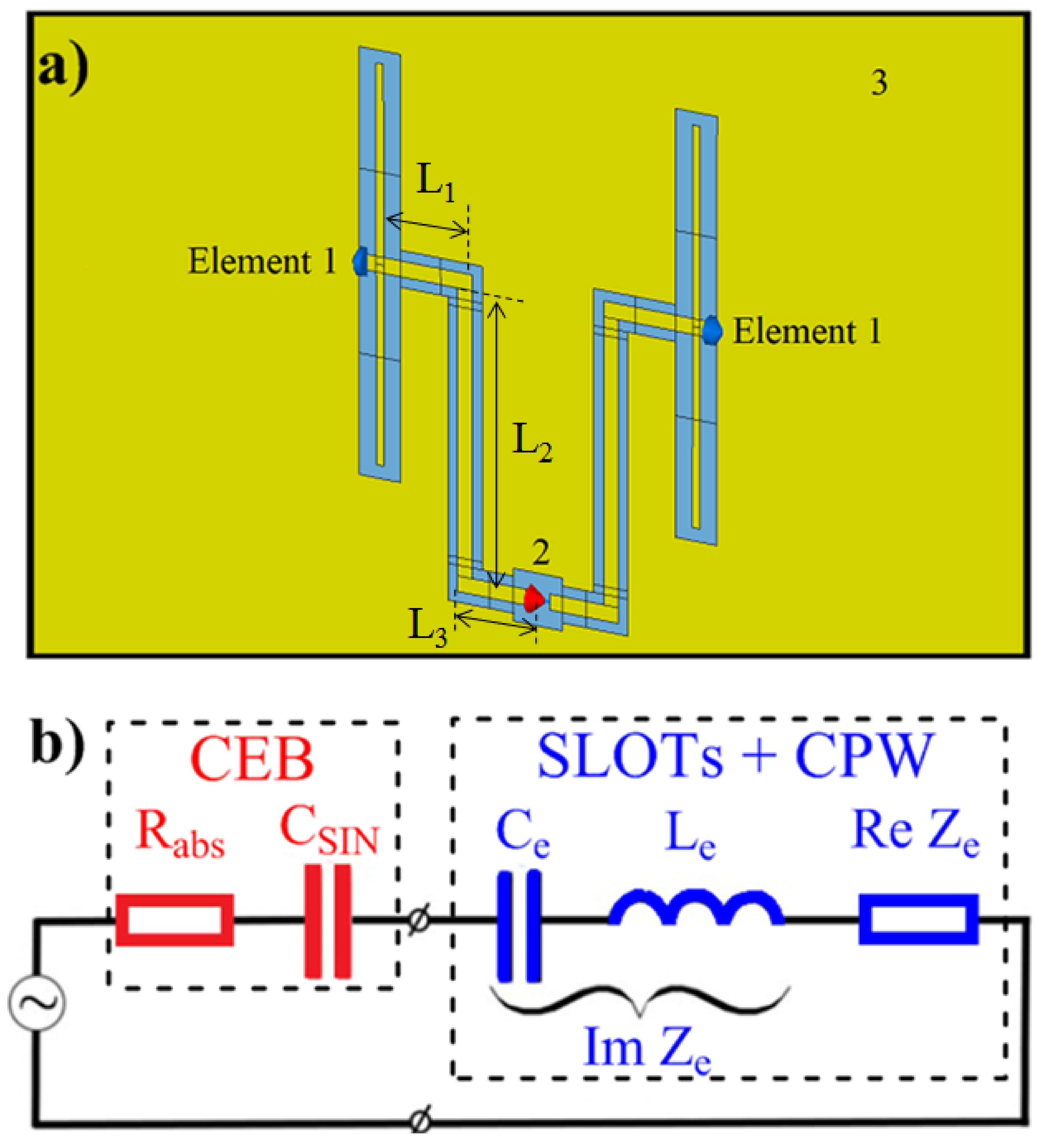
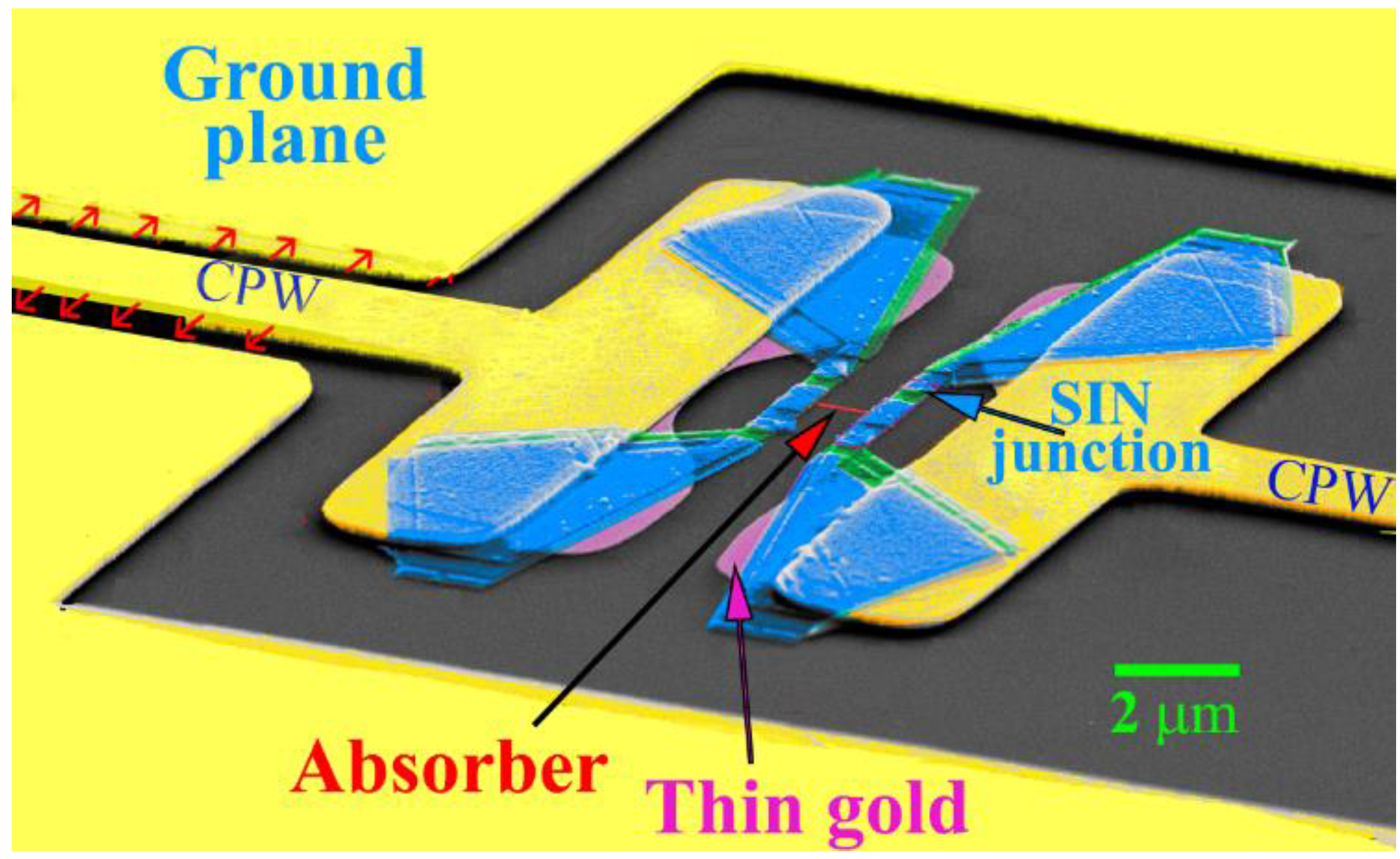
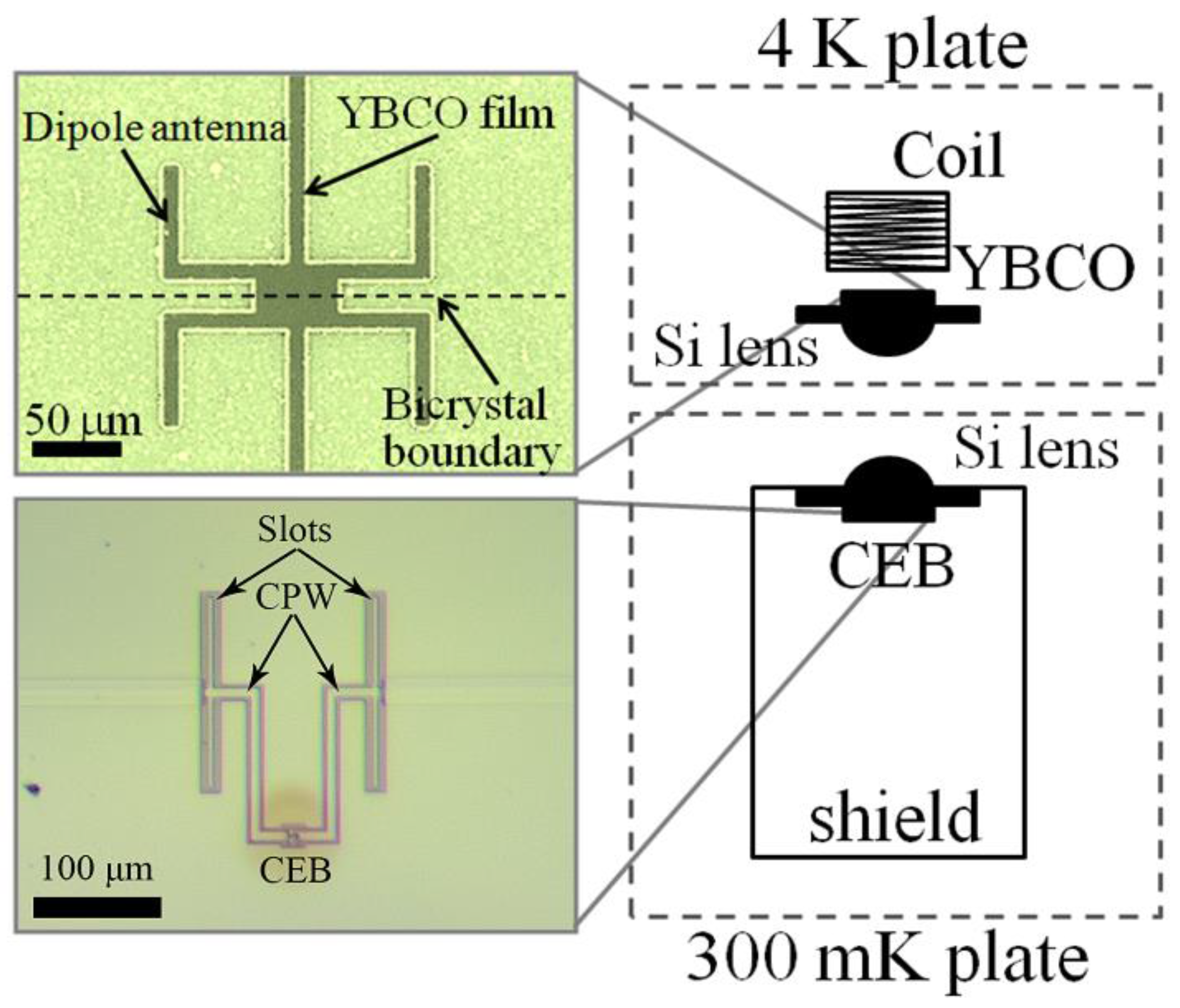
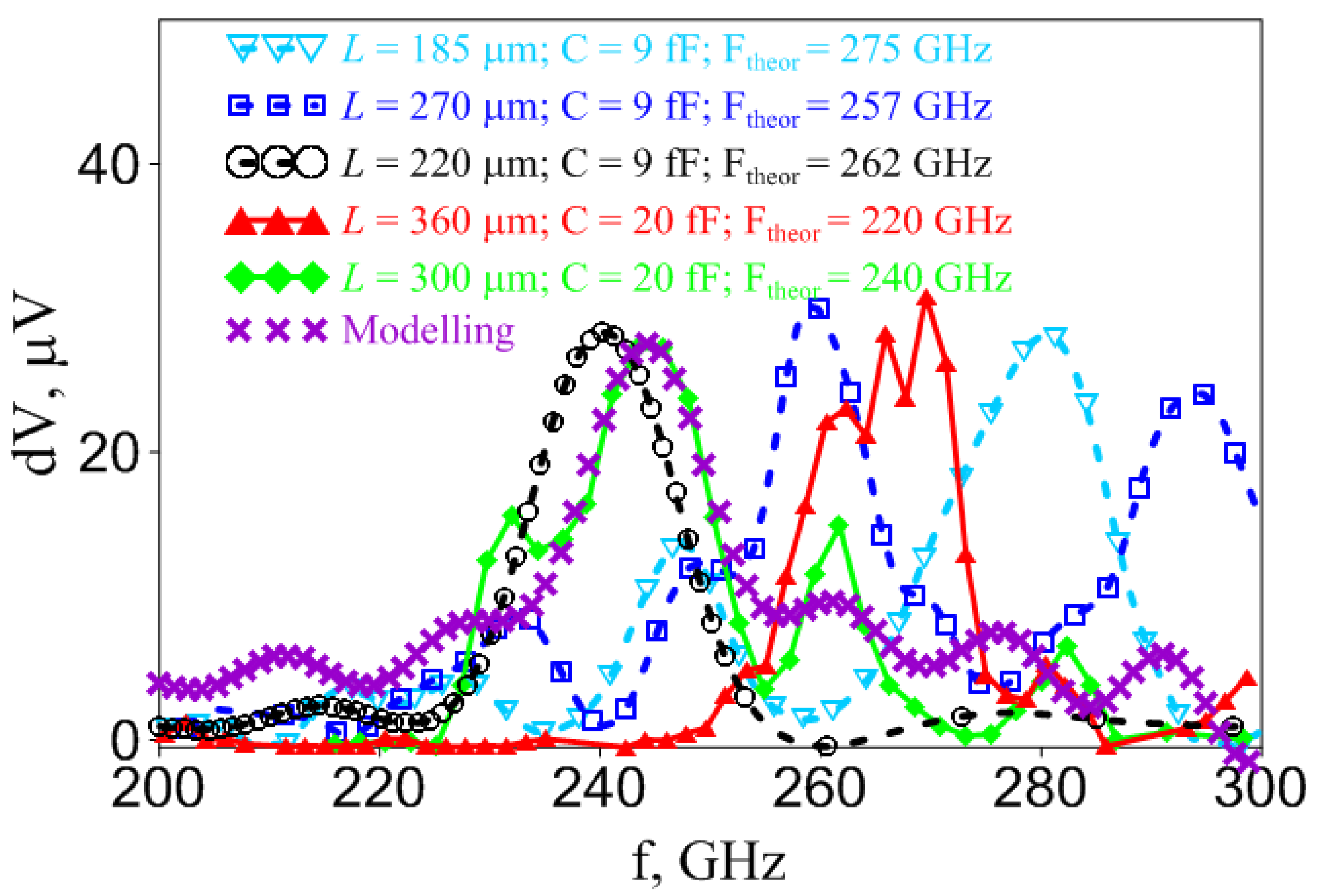
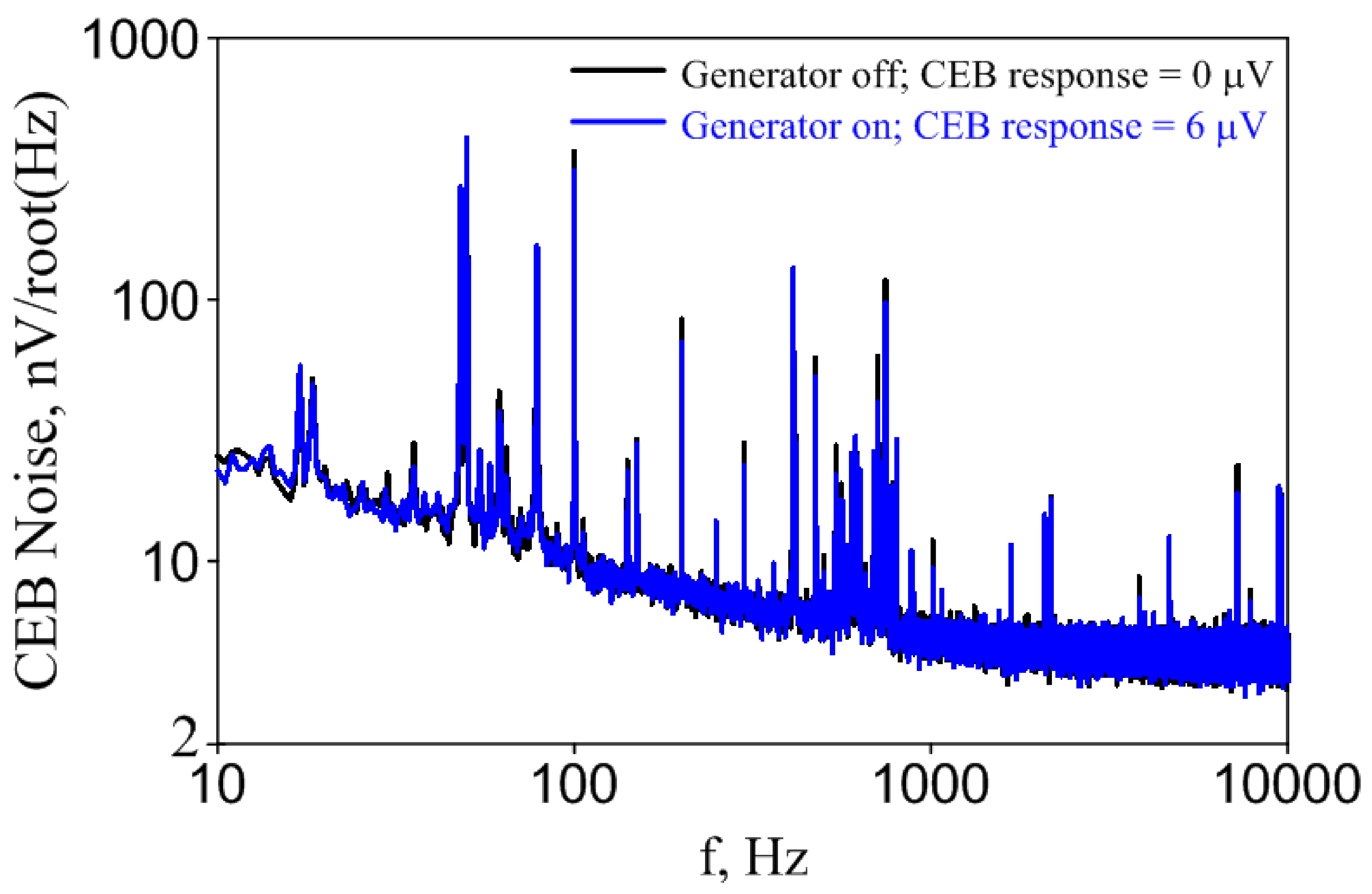
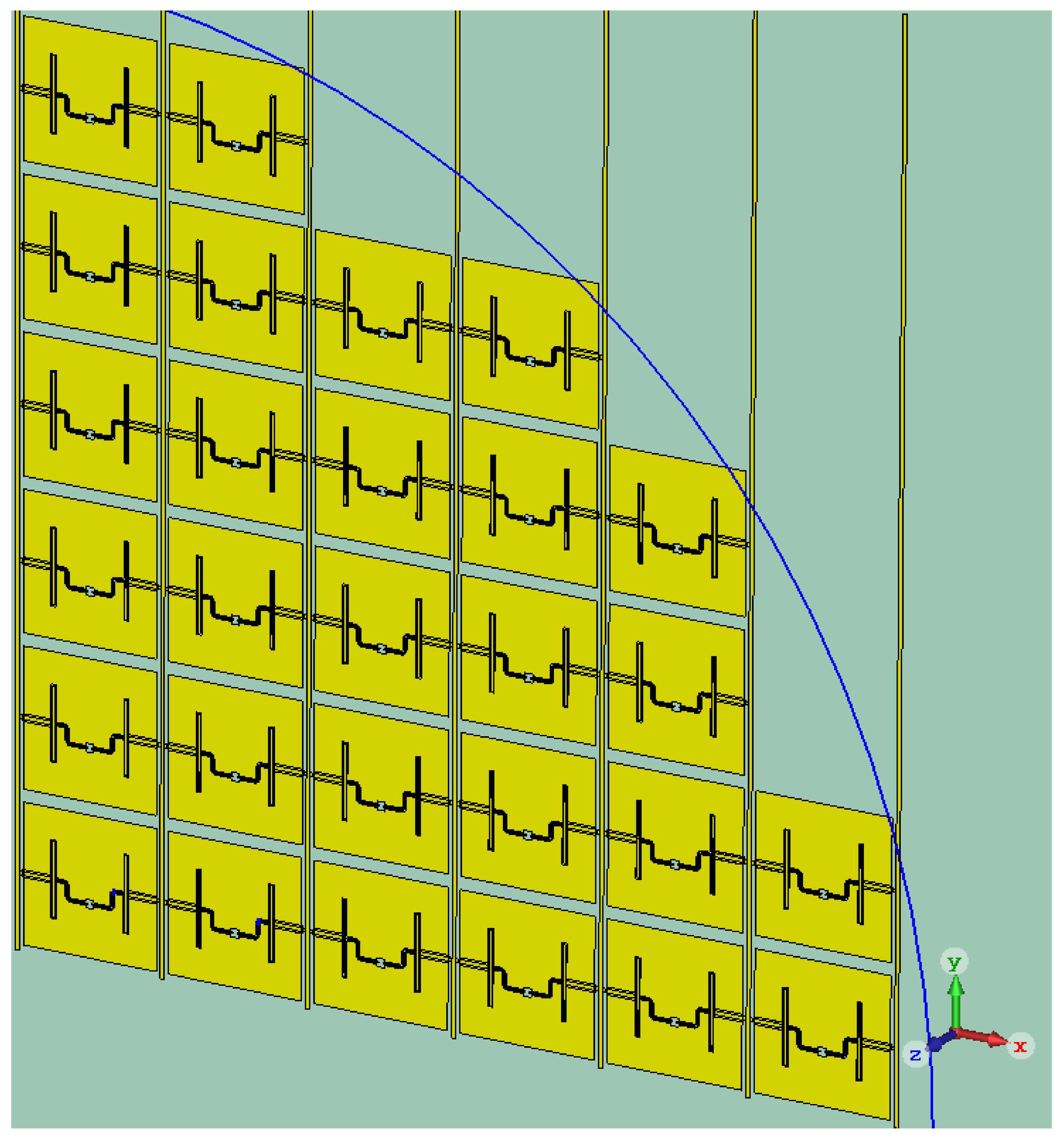
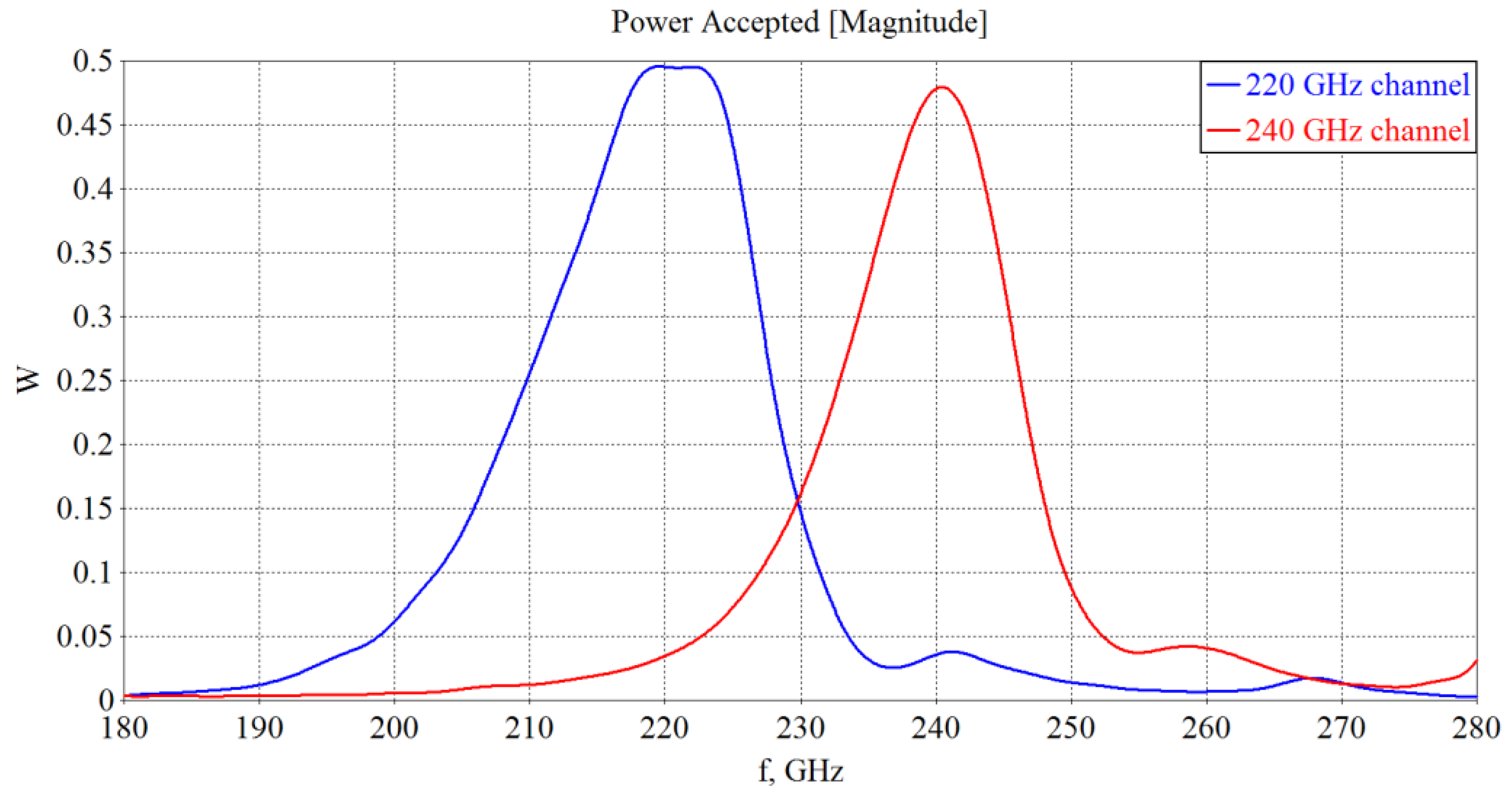
Publisher’s Note: MDPI stays neutral with regard to jurisdictional claims in published maps and institutional affiliations. |
© 2021 by the authors. Licensee MDPI, Basel, Switzerland. This article is an open access article distributed under the terms and conditions of the Creative Commons Attribution (CC BY) license (https://creativecommons.org/licenses/by/4.0/).
Share and Cite
Revin, L.S.; Pimanov, D.A.; Blagodatkin, A.V.; Gordeeva, A.V.; Pankratov, A.L.; Chiginev, A.V.; Rakut’, I.V.; Zbrozhek, V.O.; Kuzmin, L.S.; Masi, S.; et al. Spectral Characteristics of the Double-Folded Slot Antennas with Cold-Electron Bolometers for the 220/240 GHz Channels of the LSPE Instrument. Appl. Sci. 2021, 11, 10746. https://doi.org/10.3390/app112210746
Revin LS, Pimanov DA, Blagodatkin AV, Gordeeva AV, Pankratov AL, Chiginev AV, Rakut’ IV, Zbrozhek VO, Kuzmin LS, Masi S, et al. Spectral Characteristics of the Double-Folded Slot Antennas with Cold-Electron Bolometers for the 220/240 GHz Channels of the LSPE Instrument. Applied Sciences. 2021; 11(22):10746. https://doi.org/10.3390/app112210746
Chicago/Turabian StyleRevin, Leonid S., Dmitry A. Pimanov, Anton V. Blagodatkin, Anna V. Gordeeva, Andrey L. Pankratov, Alexander V. Chiginev, Igor V. Rakut’, Viktor O. Zbrozhek, Leonid S. Kuzmin, Silvia Masi, and et al. 2021. "Spectral Characteristics of the Double-Folded Slot Antennas with Cold-Electron Bolometers for the 220/240 GHz Channels of the LSPE Instrument" Applied Sciences 11, no. 22: 10746. https://doi.org/10.3390/app112210746
APA StyleRevin, L. S., Pimanov, D. A., Blagodatkin, A. V., Gordeeva, A. V., Pankratov, A. L., Chiginev, A. V., Rakut’, I. V., Zbrozhek, V. O., Kuzmin, L. S., Masi, S., & de Bernardis, P. (2021). Spectral Characteristics of the Double-Folded Slot Antennas with Cold-Electron Bolometers for the 220/240 GHz Channels of the LSPE Instrument. Applied Sciences, 11(22), 10746. https://doi.org/10.3390/app112210746








